2014 NISSAN LEAF seats
[x] Cancel search: seatsPage 255 of 397
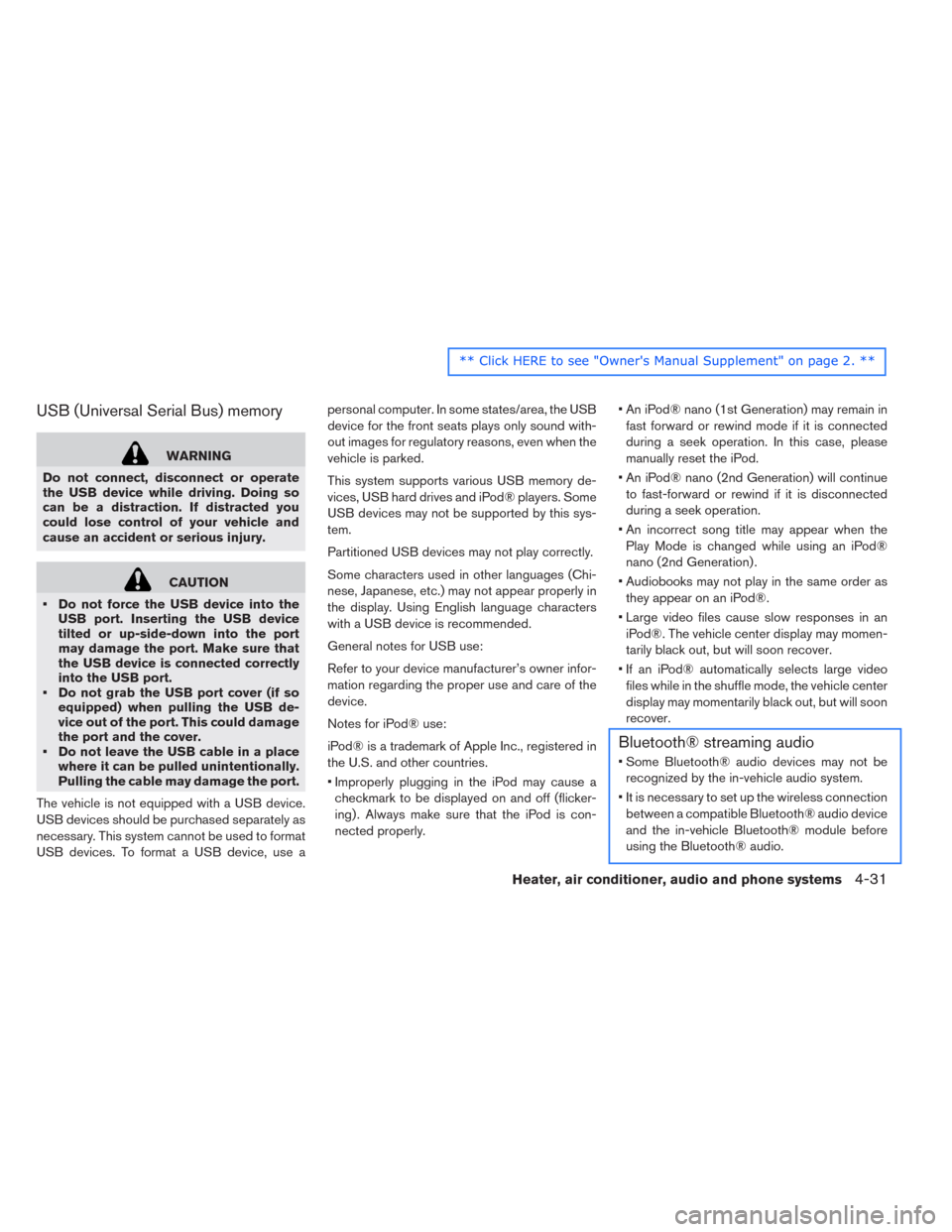
USB (Universal Serial Bus) memory
WARNING
Do not connect, disconnect or operate
the USB device while driving. Doing so
can be a distraction. If distracted you
could lose control of your vehicle and
cause an accident or serious injury.
CAUTION
• Do not force the USB device into the
USB port. Inserting the USB device
tilted or up-side-down into the port
may damage the port. Make sure that
the USB device is connected correctly
into the USB port.
• Do not grab the USB port cover (if so
equipped) when pulling the USB de-
vice out of the port. This could damage
the port and the cover.
• Do not leave the USB cable in a place
where it can be pulled unintentionally.
Pulling the cable may damage the port.
The vehicle is not equipped with a USB device.
USB devices should be purchased separately as
necessary. This system cannot be used to format
USB devices. To format a USB device, use apersonal computer. In some states/area, the USB
device for the front seats plays only sound with-
out images for regulatory reasons, even when the
vehicle is parked.
This system supports various USB memory de-
vices, USB hard drives and iPod® players. Some
USB devices may not be supported by this sys-
tem.
Partitioned USB devices may not play correctly.
Some characters used in other languages (Chi-
nese, Japanese, etc.) may not appear properly in
the display. Using English language characters
with a USB device is recommended.
General notes for USB use:
Refer to your device manufacturer’s owner infor-
mation regarding the proper use and care of the
device.
Notes for iPod® use:
iPod® is a trademark of Apple Inc., registered in
the U.S. and other countries.
• Improperly plugging in the iPod may cause a
checkmark to be displayed on and off (flicker-
ing) . Always make sure that the iPod is con-
nected properly.• An iPod® nano (1st Generation) may remain in
fast forward or rewind mode if it is connected
during a seek operation. In this case, please
manually reset the iPod.
• An iPod® nano (2nd Generation) will continue
to fast-forward or rewind if it is disconnected
during a seek operation.
• An incorrect song title may appear when the
Play Mode is changed while using an iPod®
nano (2nd Generation) .
• Audiobooks may not play in the same order as
they appear on an iPod®.
• Large video files cause slow responses in an
iPod®. The vehicle center display may momen-
tarily black out, but will soon recover.
• If an iPod® automatically selects large video
files while in the shuffle mode, the vehicle center
display may momentarily black out, but will soon
recover.
Bluetooth® streaming audio
• Some Bluetooth® audio devices may not be
recognized by the in-vehicle audio system.
• It is necessary to set up the wireless connection
between a compatible Bluetooth® audio device
and the in-vehicle Bluetooth® module before
using the Bluetooth® audio.
Heater, air conditioner, audio and phone systems4-31
Page 285 of 397
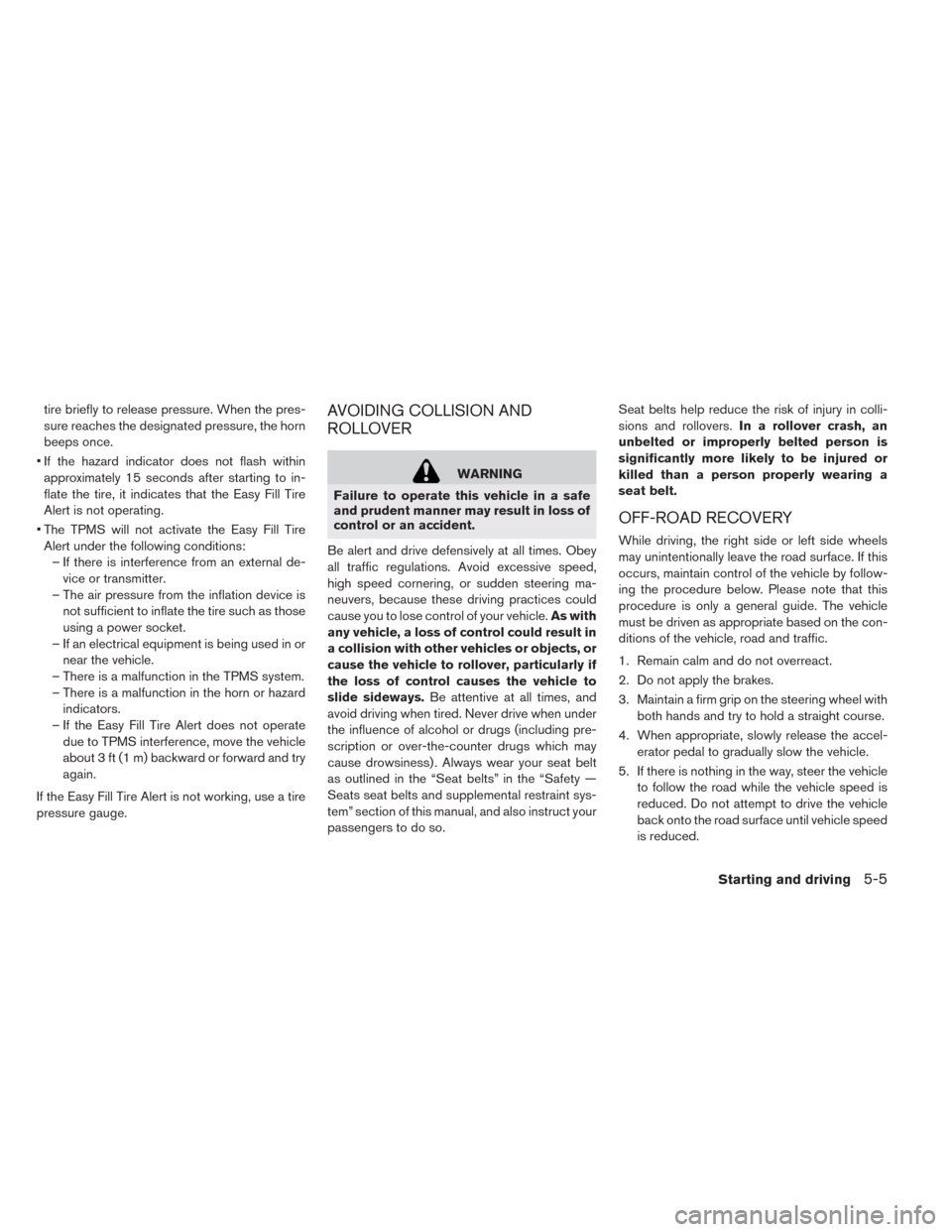
tire briefly to release pressure. When the pres-
sure reaches the designated pressure, the horn
beeps once.
• If the hazard indicator does not flash within
approximately 15 seconds after starting to in-
flate the tire, it indicates that the Easy Fill Tire
Alert is not operating.
• The TPMS will not activate the Easy Fill Tire
Alert under the following conditions:
– If there is interference from an external de-
vice or transmitter.
– The air pressure from the inflation device is
not sufficient to inflate the tire such as those
using a power socket.
– If an electrical equipment is being used in or
near the vehicle.
– There is a malfunction in the TPMS system.
– There is a malfunction in the horn or hazard
indicators.
– If the Easy Fill Tire Alert does not operate
due to TPMS interference, move the vehicle
about 3 ft (1 m) backward or forward and try
again.
If the Easy Fill Tire Alert is not working, use a tire
pressure gauge.AVOIDING COLLISION AND
ROLLOVER
WARNING
Failure to operate this vehicle in a safe
and prudent manner may result in loss of
control or an accident.
Be alert and drive defensively at all times. Obey
all traffic regulations. Avoid excessive speed,
high speed cornering, or sudden steering ma-
neuvers, because these driving practices could
cause you to lose control of your vehicle.As with
any vehicle, a loss of control could result in
a collision with other vehicles or objects, or
cause the vehicle to rollover, particularly if
the loss of control causes the vehicle to
slide sideways.Be attentive at all times, and
avoid driving when tired. Never drive when under
the influence of alcohol or drugs (including pre-
scription or over-the-counter drugs which may
cause drowsiness) . Always wear your seat belt
as outlined in the “Seat belts” in the “Safety —
Seats seat belts and supplemental restraint sys-
tem” section of this manual, and also instruct your
passengers to do so.Seat belts help reduce the risk of injury in colli-
sions and rollovers.In a rollover crash, an
unbelted or improperly belted person is
significantly more likely to be injured or
killed than a person properly wearing a
seat belt.
OFF-ROAD RECOVERY
While driving, the right side or left side wheels
may unintentionally leave the road surface. If this
occurs, maintain control of the vehicle by follow-
ing the procedure below. Please note that this
procedure is only a general guide. The vehicle
must be driven as appropriate based on the con-
ditions of the vehicle, road and traffic.
1. Remain calm and do not overreact.
2. Do not apply the brakes.
3. Maintain a firm grip on the steering wheel with
both hands and try to hold a straight course.
4. When appropriate, slowly release the accel-
erator pedal to gradually slow the vehicle.
5. If there is nothing in the way, steer the vehicle
to follow the road while the vehicle speed is
reduced. Do not attempt to drive the vehicle
back onto the road surface until vehicle speed
is reduced.
Starting and driving5-5
Page 328 of 397

CHROME PARTS
Clean chrome parts regularly with a non- abrasive
chrome polish to maintain the finish.
TIRE DRESSING
NISSAN does not recommend the use of tire
dressings. Tire manufacturers apply a coating to
the tires to help reduce discoloration of the rub-
ber. If a tire dressing is applied to the tires, it may
react with the coating and form a compound. This
compound may come off the tire while driving and
stain the vehicle paint.
If you choose to use a tire dressing, take the
following precautions:
• Use a water-based tire dressing. The coating on
the tire dissolves more easily with an oil-based
tire dressing.
• Apply a light coat of tire dressing to help prevent
it from entering the tire tread/grooves (where it
would be difficult to remove) .
• Wipe off excess tire dressing using a dry towel.
Make sure the tire dressing is completely re-
moved from the tire tread/grooves.
• Allow the tire dressing to dry as recommended
by the tire dressing manufacturer.Occasionally remove loose dust from the interior
trim, plastic parts and seats using a vacuum
cleaner or soft bristled brush. Wipe the vinyl and
leather surfaces with a clean, soft cloth damp-
ened in mild soap solution, then wipe clean with a
dry soft cloth.
Regular care and cleaning is required in order to
maintain the appearance of the leather.
Before using any fabric protector, read the manu-
facturer’s recommendations. Some fabric pro-
tectors contain chemicals that may stain or
bleach the seat material.
Use a cloth dampened only with water to clean
the meter and gauge lens.
WARNING
Do not use water or acidic cleaners (hot
steam cleaners) on the seat. This can
damage the seat or occupant classifica-
tion sensor. This can also affect the op-
eration of the air bag system and result in
serious personal injury.
CAUTION
• Never use benzine, thinner, or any
similar material.• Small dirt particles can be abrasive
and damaging to the leather surfaces
and should be removed promptly. Do
not use saddle soap, car waxes, pol-
ishes, oils, cleaning fluids, solvents,
detergents or ammonia-based clean-
ers as they may damage the leather’s
natural finish.
• Never use fabric protectors unless rec-
ommended by the manufacturer.
• Do not use glass or plastic cleaner on
meter or gauge lens covers. It may
damage the lens cover.
AIR FRESHENERS
Most air fresheners use a solvent that could affect
the vehicle interior. If you use an air freshener,
take the following precautions:
• Hanging-type air fresheners can cause perma-
nent discoloration when they contact vehicle
interior surfaces. Place the air freshener in a
location that allows it to hang free and not
contact an interior surface.
• Liquid-type air fresheners typically clip on the
vents. These products can cause immediate
damage and discoloration when spilled on inte-
rior surfaces.
CLEANING INTERIOR
7-4Appearance and care
Page 330 of 397
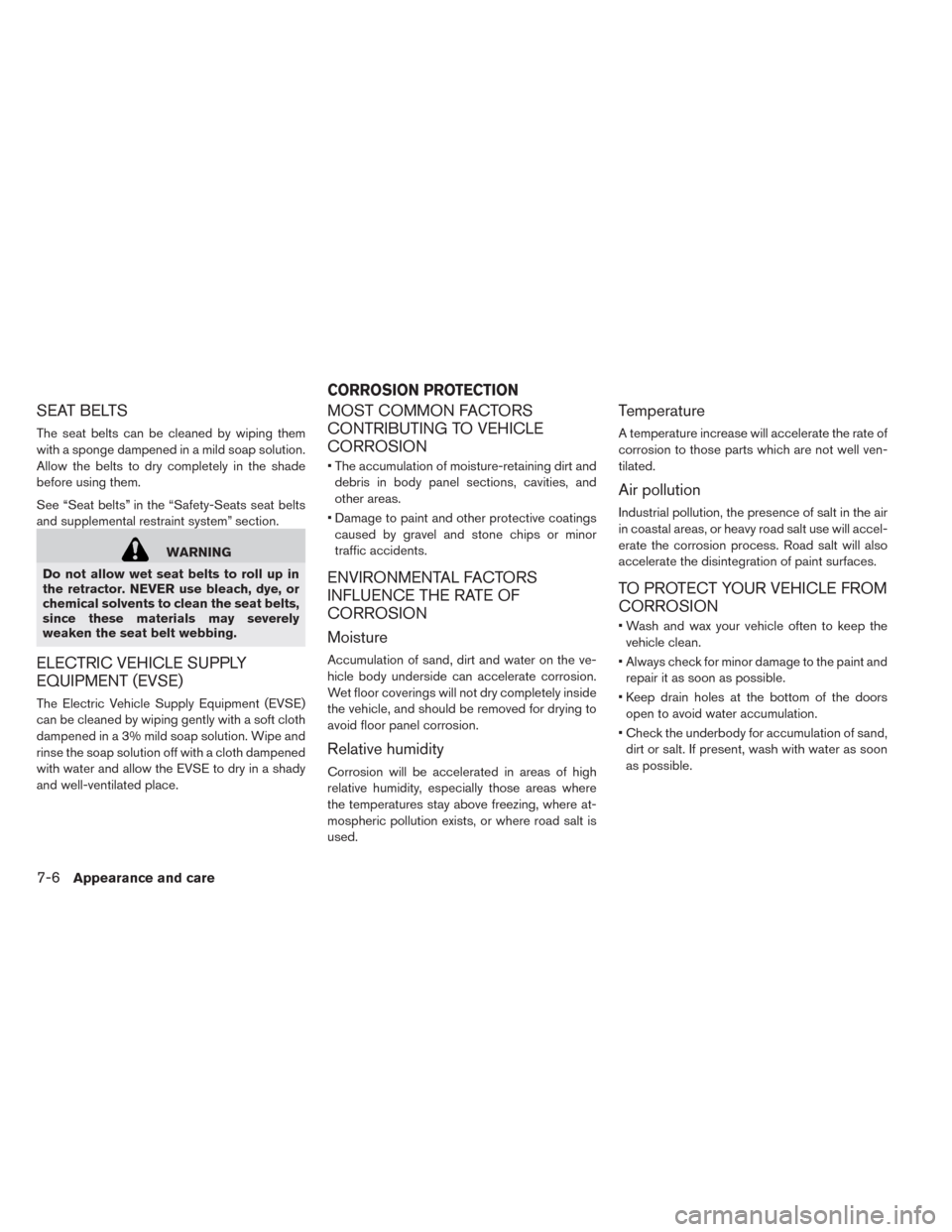
SEAT BELTS
The seat belts can be cleaned by wiping them
with a sponge dampened in a mild soap solution.
Allow the belts to dry completely in the shade
before using them.
See “Seat belts” in the “Safety-Seats seat belts
and supplemental restraint system” section.
WARNING
Do not allow wet seat belts to roll up in
the retractor. NEVER use bleach, dye, or
chemical solvents to clean the seat belts,
since these materials may severely
weaken the seat belt webbing.
ELECTRIC VEHICLE SUPPLY
EQUIPMENT (EVSE)
The Electric Vehicle Supply Equipment (EVSE)
can be cleaned by wiping gently with a soft cloth
dampened in a 3% mild soap solution. Wipe and
rinse the soap solution off with a cloth dampened
with water and allow the EVSE to dry in a shady
and well-ventilated place.
MOST COMMON FACTORS
CONTRIBUTING TO VEHICLE
CORROSION
• The accumulation of moisture-retaining dirt and
debris in body panel sections, cavities, and
other areas.
• Damage to paint and other protective coatings
caused by gravel and stone chips or minor
traffic accidents.
ENVIRONMENTAL FACTORS
INFLUENCE THE RATE OF
CORROSION
Moisture
Accumulation of sand, dirt and water on the ve-
hicle body underside can accelerate corrosion.
Wet floor coverings will not dry completely inside
the vehicle, and should be removed for drying to
avoid floor panel corrosion.
Relative humidity
Corrosion will be accelerated in areas of high
relative humidity, especially those areas where
the temperatures stay above freezing, where at-
mospheric pollution exists, or where road salt is
used.
Temperature
A temperature increase will accelerate the rate of
corrosion to those parts which are not well ven-
tilated.
Air pollution
Industrial pollution, the presence of salt in the air
in coastal areas, or heavy road salt use will accel-
erate the corrosion process. Road salt will also
accelerate the disintegration of paint surfaces.
TO PROTECT YOUR VEHICLE FROM
CORROSION
• Wash and wax your vehicle often to keep the
vehicle clean.
• Always check for minor damage to the paint and
repair it as soon as possible.
• Keep drain holes at the bottom of the doors
open to avoid water accumulation.
• Check the underbody for accumulation of sand,
dirt or salt. If present, wash with water as soon
as possible.
CORROSION PROTECTION
7-6Appearance and care
Page 376 of 397

3. Remove the license plate bracket and con-
nect the arcs from the ovals. Mark the point in
the center of each oval. These are pilot drilling
locations.
Use a 0.49 in (12.5 mm) drill bit for the license
plate screw holes and carefully open holes in
the places marked. (Make sure that the drill
only goes through the fascia.)
4. Install the license plate with two 0.23 in (6
mm) screws.
WARNING
• It is extremely dangerous to ride in the
cargo area inside the vehicle. In a col-
lision, people riding in these areas are
more likely to be seriously injured or
killed.
• Do not allow people to ride in any area
of your vehicle that is not equipped
with seats and seat belts.
• Be sure everyone in your vehicle is in a
seat and using a seat belt properly.
TERMS
It is important to familiarize yourself with the fol-
lowing terms before loading your vehicle:
• Curb Weight (actual weight of your vehicle) -
vehicle weight including: standard and optional
equipment, fluids, emergency tools, and spare
tire assembly. This weightdoes notinclude
passengers and cargo.
• GVW (Gross Vehicle Weight) - curb weight
plus the combined weight of passengers and
cargo.
• GVWR (Gross Vehicle Weight Rating) - maxi-
mum total combined weight of the unloaded
vehicle, passengers, luggage, hitch, trailer
tongue load and any other optional equipment.This information is located on the F.M.V.S.S./
C.M.V.S.S. label.
• GAWR (Gross Axle Weight Rating) - maximum
weight (load) limit specified for the front or rear
axle. This information is located on the
F.M.V.S.S./C.M.V.S.S. label.
• GCWR (Gross Combined Weight Rating) - The
maximum total weight rating of the vehicle, pas-
sengers, cargo, and trailer.
• Vehicle Capacity Weight, Load limit, Total load
capacity - maximum total weight limit specified
of the load (passengers and cargo) for the ve-
hicle. This is the maximum combined weight of
occupants and cargo that can be loaded into
the vehicle. If the vehicle is used to tow a trailer,
the trailer tongue weight must be included as
part of the cargo load. This information is lo-
cated on the Tire and Loading Information label.
• Cargo capacity - permissible weight of cargo,
the subtracted weight of occupants from the
load limit.
VEHICLE LOAD CAPACITY
Do not exceed the load limit of your vehicle
shown as “The combined weight of occupants
and cargo” on the Tire and Loading Information
label. Do not exceed the number of occupants
VEHICLE LOADING INFORMATION
9-10Technical and consumer information
Page 389 of 397

10 Index
A
ABS (Anti-lock Braking System)........5-22
Advanced air bag system............1-41
Air bag system..................1-41
Advanced air bag system..........1-41
Front passenger air bag and status light . .1-42
Front-seat mounted side-impact
supplemental air bag system........1-45
Roof-mounted curtain side-impact
supplemental air bag system........1-45
Airbagwarninglabels..............1-48
Airbagwarninglight...........1-48,2-19
Air conditioner...................9-9
Air conditioner specification label.......9-9
Air conditioning system refrigerant and lubricant
recommendations...............9-3
Alarm, How to stop alarm (see vehicle security
system)......................2-38
Alcohol, drugs and driving............5-6
Anti-lock Braking System (ABS)........5-22
Anti-lock braking system (ABS) warning light .2-15
Appearance care.................7-2
Exterior appearance care...........7-2
Interior appearance care............7-4Audible reminders................2-22
Autolight system.................2-43
Automatic.....................3-5
Door locks...................3-5
Automatic climate control (models with
Navigation System)...............4-16
Automatic climate control (models without
Navigation System)...............4-10
Avoiding collision and rollover..........5-5
B
Battery......................8-12
12-volt battery................8-12
Battery saver system.............2-44
Intelligent Key battery............8-19
Li-ion battery.................EV-2
Li-ion battery temperature gauge.......2-7
Before starting system.............5-10
Boosterseats ..................1-32
Brake.......................5-15
Anti-lock Braking System (ABS)......5-22
Brake fluid...................8-10
Brakes.....................8-15
Brake system.................5-20
BRAKE system warning light (yellow)....2-15
BRAKE warning light (red)..........2-16
BRAKE system warning light (yellow).....2-15BRAKE warning light (red)...........2-16
Bulb replacement................8-21
C
Cabin air filter..................4-15
Capacities and recommended lubricants....9-2
Cargocover...................2-53
Ceiling light...................2-58
Charge......................2-50
ChargetimerOFFswitch..........2-50
Charge connector lock switch.........2-50
Charge port lid switch..............2-49
Charging.....................3-18
Chargeportlid................3-18
Charging related indicator light......CH-28
Chargingtimer...............CH-21
Cleaning....................7-6
Normalcharge................CH-9
Precautions on charging..........CH-2
Quickcharge................CH-15
Specifications.................9-4
Trickle charge...............CH-11
Charging methods..............CH-21
Charging related indicator light........CH-28
Charging related remote function......CH-26
Charging status indicator light........CH-28
Charging timer.................CH-21
Page 390 of 397
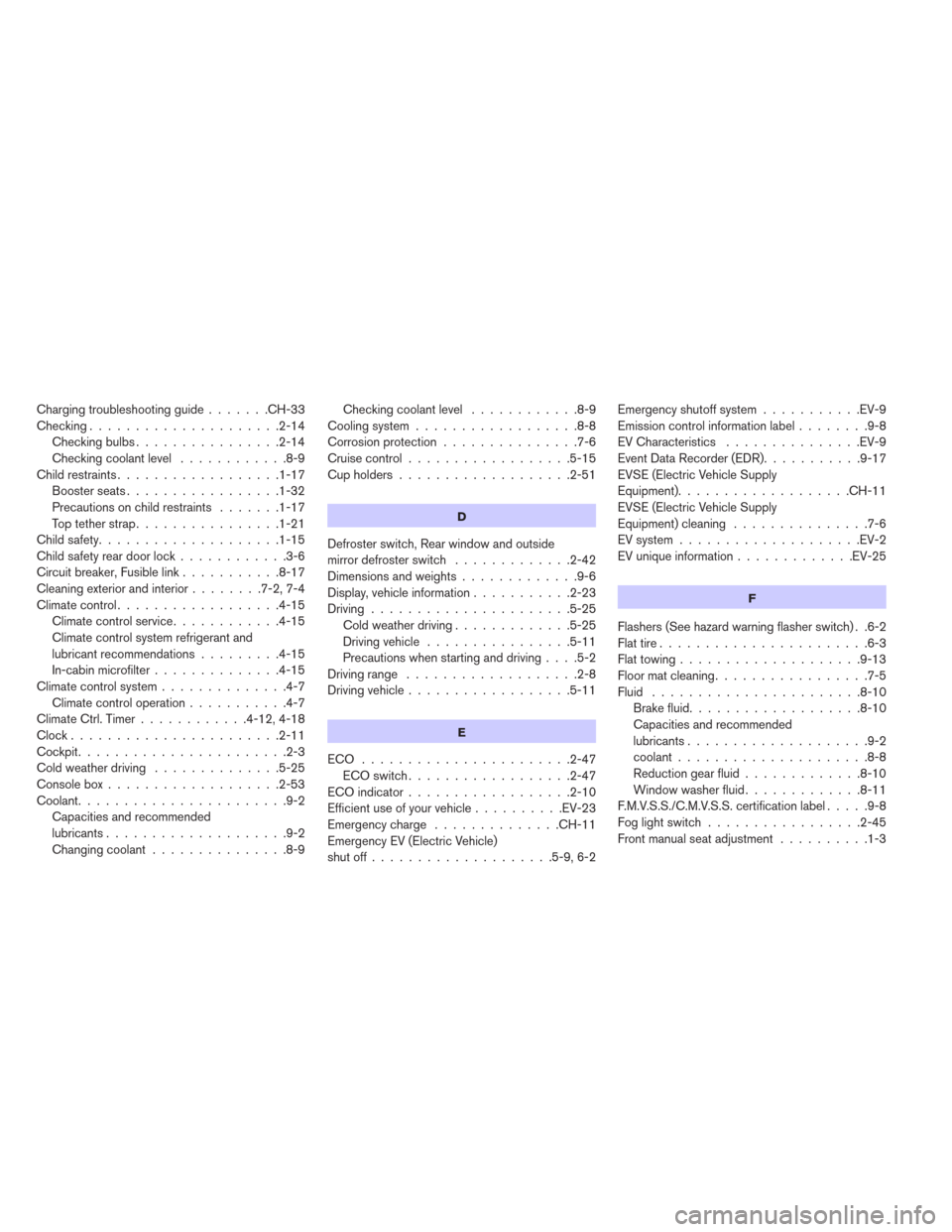
Charging troubleshooting guide.......CH-33
Checking.....................2-14
Checkingbulbs................2-14
Checkingcoolantlevel ............8-9
Child restraints..................1-17
Boosterseats.................1-32
Precautions on child restraints.......1-17
Top tether strap................1-21
Childsafety....................1-15
Child safety rear door lock............3-6
Circuit breaker, Fusible link...........8-17
Cleaning exterior and interior........7-2,7-4
Climatecontrol..................4-15
Climate control service............4-15
Climate control system refrigerant and
lubricant recommendations.........4-15
In-cabin microfilter..............4-15
Climate control system..............4-7
Climate control operation...........4-7
Climate Ctrl. Timer............4-12,4-18
Clock.......................2-11
Cockpit.......................2-3
Cold weather driving..............5-25
Consolebox...................2-53
Coolant.......................9-2
Capacities and recommended
lubricants....................9-2
Changingcoolant...............8-9Checking coolant level............8-9
Cooling system..................8-8
Corrosion protection...............7-6
Cruisecontrol..................5-15
Cupholders...................2-51
D
Defroster switch, Rear window and outside
mirror defroster switch.............2-42
Dimensionsandweights.............9-6
Display, vehicle information...........2-23
Driving......................5-25
Cold weather driving.............5-25
Driving vehicle................5-11
Precautions when starting and driving....5-2
Driving range...................2-8
Driving vehicle..................5-11
E
ECO .......................2-47
ECO switch..................2-47
ECOindicator..................2-10
Efficient use of your vehicle..........EV-23
Emergency charge..............CH-11
Emergency EV (Electric Vehicle)
shutoff....................5-9,6-2Emergency shutoff system...........EV-9
Emission control information label........9-8
EV Characteristics...............EV-9
Event Data Recorder (EDR)...........9-17
EVSE (Electric Vehicle Supply
Equipment)...................CH-11
EVSE (Electric Vehicle Supply
Equipment) cleaning...............7-6
EV system....................EV-2
EV unique information.............EV-25
F
Flashers (See hazard warning flasher switch) . .6-2
Flat tire.......................6-3
Flattowing....................9-13
Floormatcleaning.................7-5
Fluid.......................8-10
Brake fluid...................8-10
Capacities and recommended
lubricants....................9-2
coolant.....................8-8
Reductiongearfluid.............8-10
Window washer fluid.............8-11
F.M.V.S.S./C.M.V.S.S. certification label.....9-8
Foglightswitch.................2-45
Frontmanualseatadjustment ..........1-3
Page 393 of 397
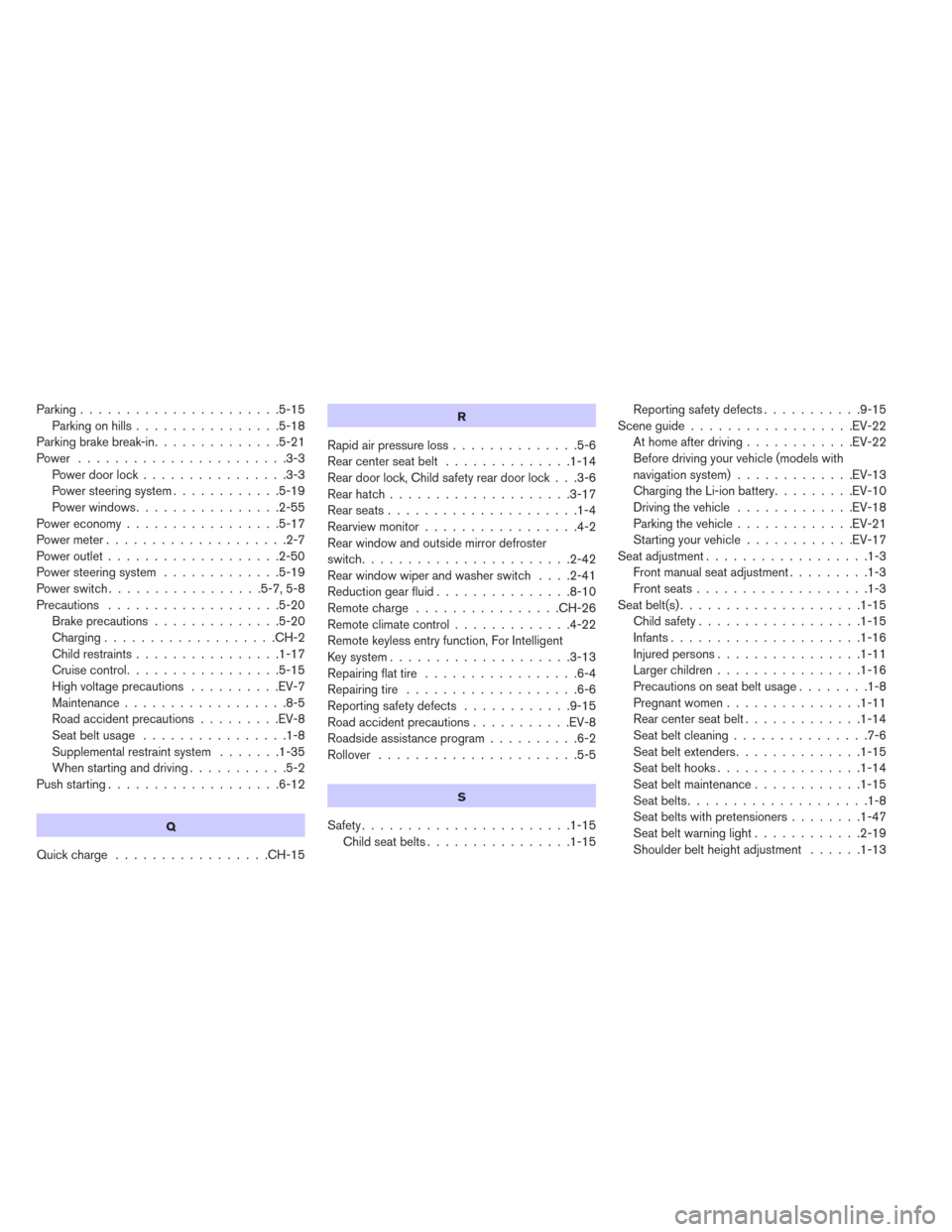
Parking......................5-15
Parking on hills................5-18
Parking brake break-in..............5-21
Power .......................3-3
Power door lock................3-3
Power steering system............5-19
Power windows................2-55
Power economy.................5-17
Powermeter....................2-7
Poweroutlet...................2-50
Power steering system.............5-19
Powerswitch.................5-7,5-8
Precautions ...................5-20
Brake precautions..............5-20
Charging...................CH-2
Child restraints................1-17
Cruisecontrol.................5-15
High voltage precautions..........EV-7
Maintenance..................8-5
Road accident precautions.........EV-8
Seatbeltusage ................1-8
Supplemental restraint system.......1-35
When starting and driving...........5-2
Push starting...................6-12
Q
Quickcharge .................CH-15
R
Rapid air pressure loss..............5-6
Rear center seat belt..............1-14
Rear door lock, Child safety rear door lock . . .3-6
Rearhatch....................3-17
Rearseats.....................1-4
Rearview monitor.................4-2
Rear window and outside mirror defroster
switch.......................2-42
Rear window wiper and washer switch....2-41
Reduction gear fluid...............8-10
Remote charge................CH-26
Remote climate control.............4-22
Remote keyless entry function, For Intelligent
Key system....................3-13
Repairing flat tire.................6-4
Repairing tire...................6-6
Reporting safety defects............9-15
Road accident precautions...........EV-8
Roadside assistance program..........6-2
Rollover ......................5-5
S
Safety.......................1-15
Childseatbelts................1-15Reporting safety defects...........9-15
Sceneguide..................EV-22
At home after driving............EV-22
Before driving your vehicle (models with
navigation system).............EV-13
Charging the Li-ion battery.........EV-10
Driving the vehicle.............EV-18
Parking the vehicle.............EV-21
Starting your vehicle............EV-17
Seat adjustment..................1-3
Frontmanualseatadjustment.........1-3
Frontseats...................1-3
Seat belt(s)....................1-15
Child safety..................1-15
Infants.....................1-16
Injured persons................1-11
Larger children................1-16
Precautions on seat belt usage........1-8
Pregnant women...............1-11
Rearcenterseatbelt.............1-14
Seat belt cleaning...............7-6
Seat belt extenders..............1-15
Seat belt hooks................1-14
Seatbeltmaintenance............1-15
Seatbelts....................1-8
Seat belts with pretensioners........1-47
Seatbeltwarninglight............2-19
Shoulder belt height adjustment......1-13